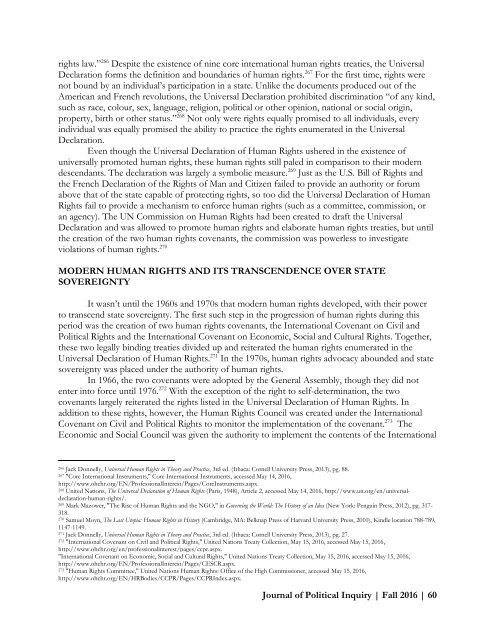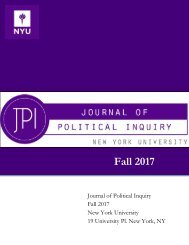Fall2016_Final
Create successful ePaper yourself
Turn your PDF publications into a flip-book with our unique Google optimized e-Paper software.
ights law.” 266 Despite the existence of nine core international human rights treaties, the Universal<br />
Declaration forms the definition and boundaries of human rights. 267 For the first time, rights were<br />
not bound by an individual’s participation in a state. Unlike the documents produced out of the<br />
American and French revolutions, the Universal Declaration prohibited discrimination “of any kind,<br />
such as race, colour, sex, language, religion, political or other opinion, national or social origin,<br />
property, birth or other status.” 268 Not only were rights equally promised to all individuals, every<br />
individual was equally promised the ability to practice the rights enumerated in the Universal<br />
Declaration.<br />
Even though the Universal Declaration of Human Rights ushered in the existence of<br />
universally promoted human rights, these human rights still paled in comparison to their modern<br />
descendants. The declaration was largely a symbolic measure. 269 Just as the U.S. Bill of Rights and<br />
the French Declaration of the Rights of Man and Citizen failed to provide an authority or forum<br />
above that of the state capable of protecting rights, so too did the Universal Declaration of Human<br />
Rights fail to provide a mechanism to enforce human rights (such as a committee, commission, or<br />
an agency). The UN Commission on Human Rights had been created to draft the Universal<br />
Declaration and was allowed to promote human rights and elaborate human rights treaties, but until<br />
the creation of the two human rights covenants, the commission was powerless to investigate<br />
violations of human rights. 270<br />
MODERN HUMAN RIGHTS AND ITS TRANSCENDENCE OVER STATE<br />
SOVEREIGNTY<br />
It wasn’t until the 1960s and 1970s that modern human rights developed, with their power<br />
to transcend state sovereignty. The first such step in the progression of human rights during this<br />
period was the creation of two human rights covenants, the International Covenant on Civil and<br />
Political Rights and the International Covenant on Economic, Social and Cultural Rights. Together,<br />
these two legally binding treaties divided up and reiterated the human rights enumerated in the<br />
Universal Declaration of Human Rights. 271 In the 1970s, human rights advocacy abounded and state<br />
sovereignty was placed under the authority of human rights.<br />
In 1966, the two covenants were adopted by the General Assembly, though they did not<br />
enter into force until 1976. 272 With the exception of the right to self-determination, the two<br />
covenants largely reiterated the rights listed in the Universal Declaration of Human Rights. In<br />
addition to these rights, however, the Human Rights Council was created under the International<br />
Covenant on Civil and Political Rights to monitor the implementation of the covenant. 273 The<br />
Economic and Social Council was given the authority to implement the contents of the International<br />
266<br />
Jack Donnelly, Universal Human Rights in Theory and Practice, 3rd ed. (Ithaca: Cornell University Press, 2013), pg. 88.<br />
267<br />
"Core International Instruments," Core International Instruments, accessed May 14, 2016,<br />
http://www.ohchr.org/EN/ProfessionalInterest/Pages/CoreInstruments.aspx.<br />
268<br />
United Nations, The Universal Declaration of Human Rights (Paris, 1948), Article 2, accessed May 14, 2016, http://www.un.org/en/universaldeclaration-human-rights/.<br />
269<br />
Mark Mazower, "The Rise of Human Rights and the NGO," in Governing the World: The History of an Idea (New York: Penguin Press, 2012), pg. 317-<br />
318.<br />
270<br />
Samuel Moyn, The Last Utopia: Human Rights in History (Cambridge, MA: Belknap Press of Harvard University Press, 2010), Kindle location 788-789,<br />
1147-1149.<br />
271<br />
Jack Donnelly, Universal Human Rights in Theory and Practice, 3rd ed. (Ithaca: Cornell University Press, 2013), pg. 27.<br />
272<br />
"International Covenant on Civil and Political Rights," United Nations Treaty Collection, May 15, 2016, accessed May 15, 2016,<br />
http://www.ohchr.org/en/professionalinterest/pages/ccpr.aspx.<br />
"International Covenant on Economic, Social and Cultural Rights," United Nations Treaty Collection, May 15, 2016, accessed May 15, 2016,<br />
http://www.ohchr.org/EN/ProfessionalInterest/Pages/CESCR.aspx.<br />
273<br />
"Human Rights Committee," United Nations Human Rights: Office of the High Commissioner, accessed May 15, 2016,<br />
http://www.ohchr.org/EN/HRBodies/CCPR/Pages/CCPRIndex.aspx.<br />
Journal of Political Inquiry | Fall 2016 | 60
















